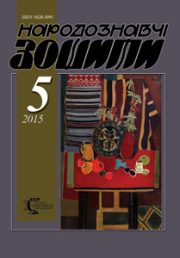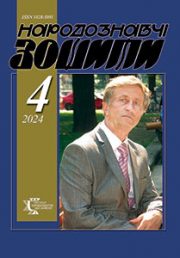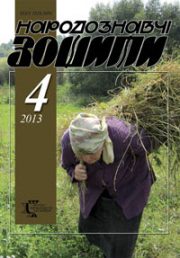The Ethnology Notebooks. 2021. № 4 (160), 818—830
UDK[94:35.081.74:329.15](477.8)”1939/1941″
DOI https://doi.org/10.15407/nz2021.04.818
STASYUK Oleksandra
- ORCID ID: https://orcid.org/0000-0002-2957-0432
- Candidate of Sciences,
- senior researcher of the
- Institute of Ukrainian Studies
- I. Krypiakevych NAS of Ukraine,
- 4, Kozelnytska Street, 79026, Lviv, Ukraine,
- Contacts: e-mail: ol_stasuk@ukr.net
Abstract. The problem urgency is related to the local self-government reform, which continues in modern Ukraine and requires thorough theoretical and methodological, philosophical, and historical-political support.
The study object is the Workers’ Deputies Soviets of Western Ukrainian regions in the system of Soviet society power relations.
The purpose of the article is to cover the role and local authorities’ significance in the Ukrainian SSR western regions during 1939—1941 on the historiographical basis and archival sources, to prove the imported nature of the process and its full control over party authorities, to show the local population’s mixed perception in general. Structural-chronological, historical-comparative, systemic, and interdisciplinary methods were used to fulfil the goals and work objectives, which ensured the study’s objectivity and thoroughness.
The author notes that as a result of the occupation in the western Ukrainian region, the democratic foundations of the society organization were destroyed and a rigid totalitarian-partocratic regime was established, which operated throughout the USSR. Subordinate to the party committees, the Soviets and their executive committees played a secondary role in the Soviet administrative structures system in the region, which levelled the democracy principle and hindered the Soviets proper influence on the western regions socio-economic development. As a result, socio-economic transformations in the region have been ambiguous and sometimes contradictory. In particular, the nationalization process of large-scale industry and landed and ecclesiastical lands, due to the specific instructions lack from local authorities or their neglect by those responsible, turned into the region looting and its inhabitants. Large-scale shifts in the economic sector due to Soviet economy «chronic diseases» (mismanagement, unbalanced planning, corruption, etc.) did not yield the expected results. And the cooperative institutions reorganization resulted in the destruction of small and medium-sized businesses, which immediately affected the region welfare and the population. The dominance of Soviet emissaries in the power region structures pointed to the Soviet regime occupation, created a alienation wall between the government and the local population, which openly or covertly sabotaged it.
Keywords: Ukrainian SSR, western region, Sovietization, a representative branch of power.
Received 10.08.2021
REFERENCES
- Lutsky, O. (2006). Lviv under Soviet occupation 1939—1941. Ukrainian liberation movement: science. zb. Lviv (Vol. 7, pp. 89—119). [in Ukrainian].
- Kucherepa, M., & Visin, V., & Kondratyuk, K. (Ed.). (2001). The Soviet regime in Volhynia (1939—1941). 1939 in the historical destiny of Ukraine and Ukrainians. Proceedings of the International Scientific Conference. September 23—24, 1999. Lviv [in Ukrainian].
- (1940, 8 January). News [in Ukrainian].
- Kravchuk, L.V. (2020). Socio-political and socio-economic transformations in Ternopil region (September 1939—June 1941). Author’s ref. dissertations for the degree of Doctor of Historical Sciences, specialty 07.00.01 — History of Ukraine. Lviv [in Ukrainian].
- Slyvkа, Yu. (Ed.). (1989). Reunification of Western Ukrainian lands with Soviet Ukraine. Kyiv [in Ukrainian].
- (1939, 20 december). Free Ukraine [in Ukrainian].
- Kulchytsky, V., &Kondratyuk, S. Establishment of Soviet authorities in Western Ukraine in 1939—1941. Retrieved from: http:radnuk.info/home/24876———1939—1941—–c.htm (19.06.2020) [in Ukrainian].
- Terletsky, V.M. (1966). Council of Deputies of Workers of the Ukrainian SSR in the period of completion of the construction of socialism (1938—1958) Kyiv [in Ukrainian].
- Resolution of the Bureau of the Rivne Regional Committee of the CP (b) U of May 21, 1940. Archive of the DАRО (State Archives of the Rivne Region). F. 400. Op. 1. Spr. 5.
- Pidlisny, Yu. (Ed.). (2014). Rehabilitated by history. Lviv region. Book second: Boryslav, Brody district. Lviv; Kyiv [in Ukrainian].
- Archive of the DALO (State Archives of Lviv Region). F. 5001. Op. 1. Spr. 16.
- Transcript of the first regional party conference on April 23—25, 1940. Archive of the DATO (State Archives of Ternopil region). F. P.-1. Op. 1. Spr. 3.
- Transcript of the 1st Drohobych Regional Conference of the CP (B) U. 27—28.04.1940 r. Archive of the DALO. F. 5001. Op. 1. Spr. 3.
- Lutsky, O. (2009). «Sovietization» of Lviv: September 1939—June 1941 pp. Retrieved from: https://map.lviv.ua/statti/luckij2.html (5.07.2021).
- Myshchak, I. (2009). Socio-economic and cultural transformations in the western Ukrainian lands after their incorporation into the USSR: modern historiography. Historical and geographical research in Ukraine (Vol. 11, pp. 276—287). Kyiv [in Ukrainian].
- Information on violations of the Revolutionary law in the Chernivtsi region for 1940. Archive of the DACНO (State Archives of Chernivtsi region ). F. 1. Op. 1. Spr. 27.
- Certificate of verification of applications received in the name of the Regional Committee of the CP (b) U from Comrade Garage — Chairman of the Hlybokaje District Executive Committee, Bryukhovich — Director of the mill, former staff member of the Hlybokaje RK KP (b) U. Archive of the DACНO. F. 1. Op. 1. Spr. 86.
- Pagirya, O. (2013) Life in the conditions of the Soviet occupation of Western Ukraine in 1939—1941. Retrieved from: http://www.territoryterror.org.ua/uk/publications/details/?newsid=253 (13.06.2021) [in Ukrainian].
- Samsonyuk, T.M. (2015). Poles of Rivne region in the conditions of formation of the Soviet totalitarian regime (1939—1941) The dissertation on competition of a scientific degree of the candidate of historical sciences on a specialty 07.00.01 — history of Ukraine. Ostrog [in Ukrainian].
- Resolution of the Presidium of the Ternopil City Council of March 19, 1940 «Consideration of applications for incorrect nationalization of property». Archive of the DATO. F. R-9. Op. 1. Spr. 105.
- Resolution of the Bureau of the Chernivtsi Regional Committee of the CP (b) U «On the location of military units of the garrison» of December 1940. Archive of the DACНO. F. 1. Op. 1. Spr. 4 [in Ukrainian].
- Chairman of the People’s Commissar of Ukraine Comrade Korniytsu LR, September 29, 1940. Archive of the GDA SBU. (Sectoral state archive of the Security Service of Ukraine). F. 16. Op. 33. Spr. 27.
- Stadnyk, G. From Occupation to Occupation: Lviv in 1939—1941. Retrieved from: https:p.dw.com/p/JENc (21.08.2009 r.) [in Ukrainian].
- Information on the facts of violation of rev-legality in the districts of Chernivtsi region. October 14, 1940. Archive of the DACНO. F. P-1. Op. 1. Spr. 27.
- Baran, V., & Tokarsky, V. (2009). Ukraine: Western Lands: 1939—1941. Lviv: Krypiakevych Institute of Ukrainian Studies of the National Academy of Sciences of Ukraine [in Ukrainian].
- Makharinets, M.E. (2021). Evolution of legal regulation of land relations in Volhynia in 1939—1960. Dissertation for the degree of Doctor of Philosophy (specialty 081 — law). Kyiv [in Ukrainian].
- Pivovarchuk, V.M. (2000). Socio-economic processes in the western regions of Ukraine (September 1939—June 1941): Abstract of the dissertation for the degree of candidate of historical sciences in the specialty: 07.00.01 — history of Ukraine. Rivne State University for the Humanities. Rivne [in Ukrainian].
- Transcript of the heads of village councils of Lviv region. Archive of the DALO. F. R-221. Op. 1. Spr. 177.
- Transcript of the meeting of secretaries of city committees, district committees of the CP (b) U, and personnel departments of Soviet and economic organizations of the Drohobych region on the selection, nomination and registration of personnel. 1940. 17 May. Archive of the TsDAGO of Ukraine (Central State Archive of Public Associations of Ukraine). F. 1. Op. 20. Spr. 7397.
- Golovko, M.L. (2004). Socio-political organizations and movements of Ukraine during the Second World War. 1939—1945. Kyiv [in Ukrainian].
- Kobrinovich, I.M. (2008). Organization and activity of the repressive and punitive system of Bolshevism in Volyn in 1939—1941. Bulletin of the National University «Lviv Polytechnic» (Vol. 612, pp. 148—152). Lviv [in Ukrainian].
- Archive of the DARO. F. 400. Op. 1. Spr. 13.
- Litvin, V.M. (Ed.). (2004). Ukraine and Russia in historical retrospect: essays: in 3 vol. (Vol. 2). Kyiv [in Ukrainian].
- Political information. April 14, 1941. Khotyn RK KP (b) U. Archive of the DACНO. F. P-1. Op. 1. Spr. 72.
- Yakovlev, A.N. (Ed.). (2006). Lubyanka. Stalin and the NKVD — NKGB — GUKR «Smersh». 1939 — March 1946. Stalin Archive. Documents of the highest bodies of party and state power. Moscow (Russia. XX century. Documents) [in Russian].






